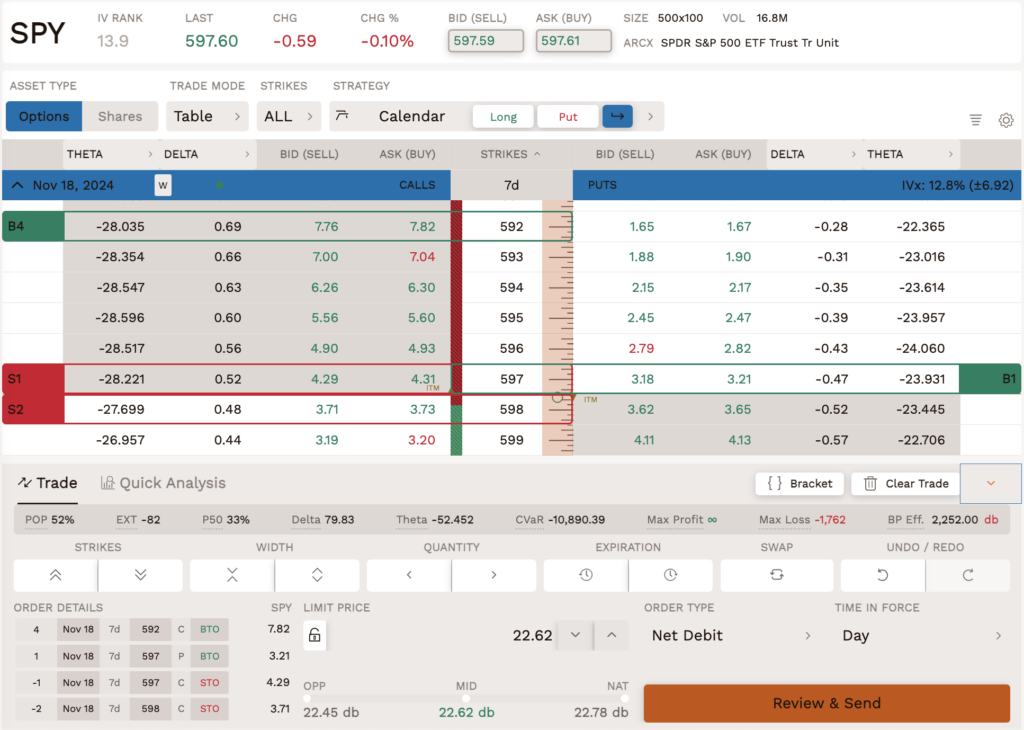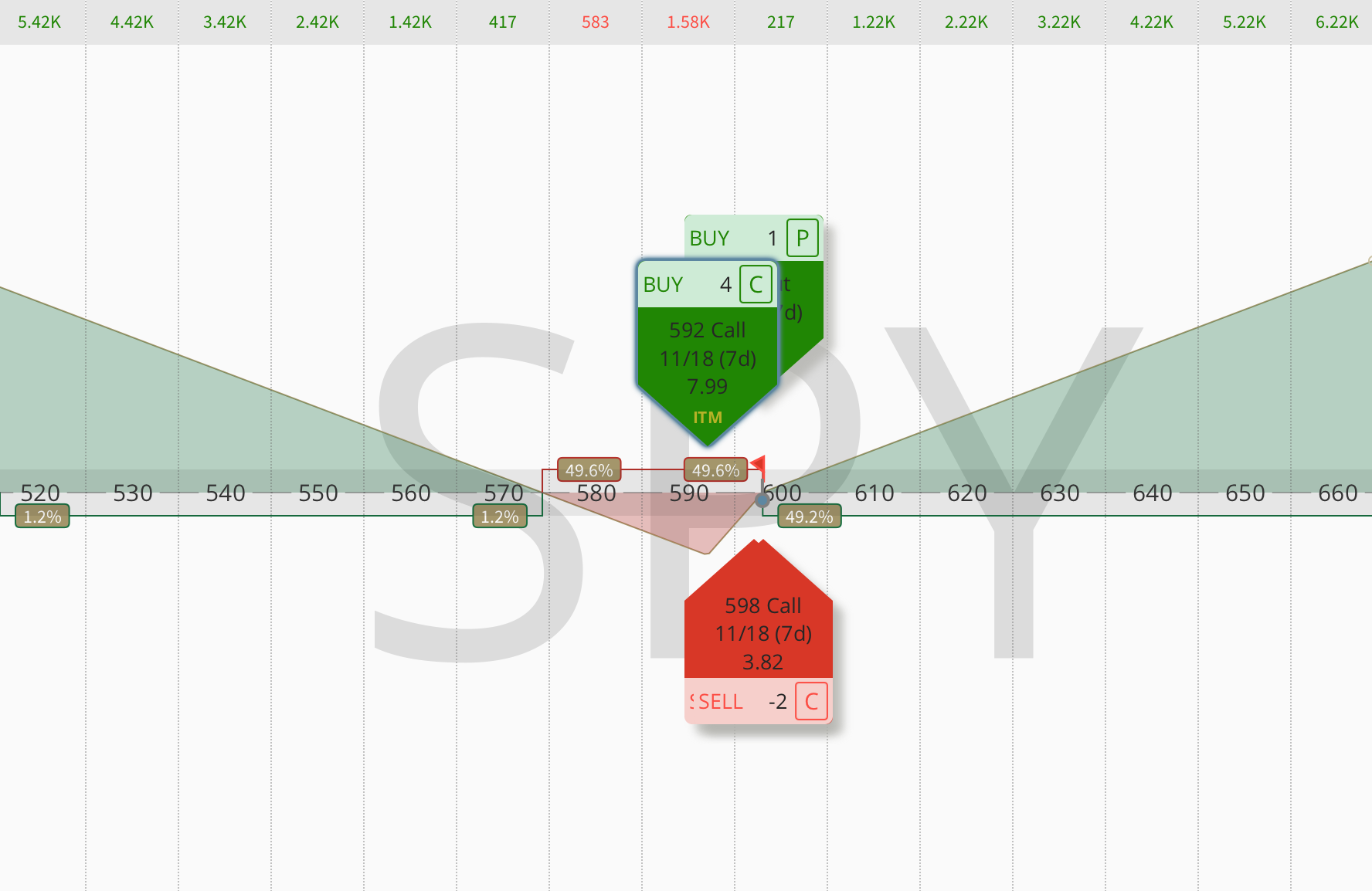In options trading, strategies can range from simple to highly complex. The Zero Extrinsic Hedged Back Spread (ZEEHBS) stands out as a sophisticated approach for experienced traders seeking to generate alpha while managing risk. Built on the foundation of the Zero Extrinsic Back Ratio Adjustment (ZEBRA) strategy, ZEEHBS offers a powerful way to capitalize on volatile markets with built-in protection. In this post I’ll explore ZEEHBS’s core mechanics, its performance, and why it’s effective in unpredictable conditions.
What is the ZEEHBS Strategy?
The Zero Extrinsic Hedged Back Spread (ZEEHBS) strategy is designed to generate alpha while providing a hedge against significant downside risk. Essentially, it’s a bullish strategy with built-in protection. It starts with the basic structure of a ZEBRA strategy, which involves buying two in-the-money call options and selling one at-the-money call option. This structure aims for zero extrinsic value, meaning there is almost no time decay. The ZEBRA acts as a stock replacement, meaning its price movement should closely mirror that of the underlying stock.
To complete the ZEEHBS, a trader adds a 50% hedge by either shorting 50 shares of the underlying asset or creating a synthetic short position using options. A synthetic short can be created by selling a call option and buying a put options at the same strike price and expiration date. This partial hedge limits downside risk and provides protection during periods of significant price swings.
The ZEEHBS functions similarly to a long straddle but has the distinct advantage of no extrinsic value and minimal time decay, making it a more cost-effective strategy. The strategy is usually implemented with a short time horizon, typically on options contracts expiring within a week. My personal preference is to execute this trade every Monday, using options with 7 DTE. This approach benefits from the strategy’s ability to capture quick, sizable moves in either direction, which can generate significant profits, while mitigating potential losses in a market downturn.
Why Use ZEEHBS?
The ZEEHBS strategy has several features that make it highly effective, particularly when deployed during low-volatility phases that precede high-volatility events. This design makes it an attractive alternative for traders seeking hedged alpha-generation methods in today’ unpredictable financial landscape. Here’re some compelling advantages:
- Low extrinsic value – Unlike a traditional long straddle, ZEEHBS eliminates most of the extrinsic value, reducing the risk associated with options time decay. This approach ensures that the majority of the premium paid is intrinsic, making it a more cost-effective strategy.
- Tail risk hedging – The strategy acts similarly to tail risk hedging, where small portions of a portfolio are allocated to out-of-the-money options to mitigate severe downturns. In ZEEHBS, this translates to a partial hedge against extreme negative price moves, protecting the portfolio in sharp downturns while allowing gains if the market bounces back.
- Alpha generation – Unlike static hedges or long-only positions, ZEEHBS benefits from price extremes. The strategy in volatile conditions, especially during earnings releases or economic announcements, or any other event expected to induce significant market swings, capturing alpha from these rapid movements.
Live Example: ZEEHBS on SPY
Consider implementing a ZEEHBS on SPY with 7 days to expiration (DTE). Here’s how to set up the trade:
- Buy 4 ITM Call Options: Choose strike prices around 70 delta (e.g., $529) to build two ZEBRAs. Each call costs approximately $7.79.
- Sell 2 ATM Call Option: Select a strike price close to 50 delta (e.g., $598) for a credit of about $3.72 each.
- Hedge: Create a synthetic short position by selling one call and buying one put at the $597 strike price.
This setup involves two ZEBRAs hedged with one synthetic short position to manage downside risk. It’s ideal to place all components as a single, multi-leg trade to ensure cohesive execution and minimize slippage. This ZEEHBS achieves near-zero extrinsic value, limiting the time decay. If SPY moves significantly in either direction, the position benefits from the intrinsic gains of the long calls while the short shares (or synthetic position) cushion potential losses.

Performance Metrics
Research conducted by Gage Marsan and James Xu, published as part of the Quant@Illinois SP24 Trading Project, provides a comprehensive backtest of the ZEEHBS strategy from January 2021 to January 2024. According to their findings, ZEEHBS demonstrates strong performance metrics compared to buy-and-hold and outperformed a traditional SPY investment. Here are some key metrics:
| Strategy | Return | Max Drawdown | Win Rate | Sharpe Ratio |
| SPY | 35.06% | -23.93% | n/a | 0.5 |
| Modified ZEEHBS | 42.61% | -9.8% | 77% | 0.554 |
These results highlight the potential for ZEEHBS to deliver strong risk-adjusted returns, making it a valuable strategy during turbulent market periods.
Implementing ZEEHBS: Key Tips
- Choose the right underlying asset. Assets that are likely to experience volatility spikes, such as major tech stocks or indices, are prime candidates for ZEEHBS. It’s crucial to select assets with the highest options liquidity. Liquidity ensures smoother execution and easier adjustments.
- Market timing. Since ZEEHBS profits from rapid price changes, deploy it when the market is calm but expected to become volatile. Events such as earnings reports or key economic releases are ideal opportunities.
- Adjustments. Regularly review the position. If the underlying asset’s price rises sharply, recalibrating the hedge can optimize returns and manage risk.
Risks and the “Valley of Death”
A notable drawback of ZEEHBS is the “valley of death”, a price range where the strategy may experience its maximum loss. This occurs when the underlying asset declines moderately, hitting a range below the ZEBRA’s in-the-money calls’ strike but not low enough to trigger profitability from the hedge. To address this risk, consider:
- Re-centering the ZEBRA: Close and re-open the ZEBRA at a lower strike price to shift the risk zone downward.
- Selling an Out-of-the-Money Call: This can provide extra credit and reduce the downside risk, effectively turning the ZEBRA into a covered call position.
- Rolling Down the Calls: If the underlying asset drops, the value of the calls will decrease. Rolling them down to lower strike prices can offer a slight hedge, although this may limit upside potential on an upside reversal.
- Selling the Long Put from the Synthetic Short: This removes continued downside protection but can help offset potential losses and adjust the risk profile when the asset is declining.
- More Adjustments: I outline additional, battle-tested adjustments for managing ZEEHBS effectively in my Trading Plan. These tweaks help minimize risk.
Is ZEEHBS Right for You?
ZEEHBS isn’t a beginner’s strategy. It requires a solid understanding of options mechanics and active management. However, for experienced traders, it offers a unique balance of alpha potential and downside protection. If you’re looking to enhance your portfolio’s performance in volatile markets, ZEEHBS is worth exploring. In today’s unpredictable environment, strategies like ZEEHBS can help you thrive. With the right preparation and execution, this approach could be a valuable addition to your trading toolkit.
